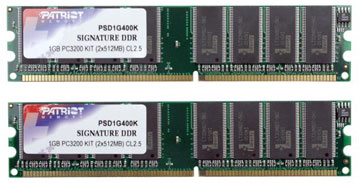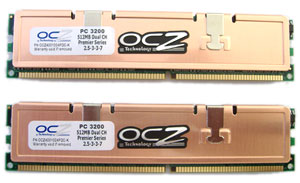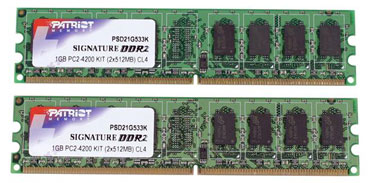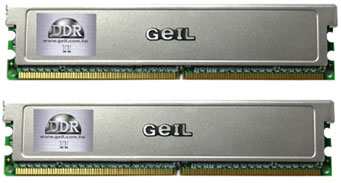Entry Level Buyer's Guide, October 2005
by Jarred Walton on October 14, 2005 12:05 AM EST- Posted in
- Guides
Memory Recommendations
We just took a look at several 1GB DIMM configurations. For the AMD socket 754 boards, it's important to remember that these are single channel memory controllers, so using two DIMMs won't help performance. Quite the opposite, in fact; some socket 754 motherboards will have problems operating two DIMMs at the fastest DDR400 speeds. We won't recommend using 2GB of RAM in a "budget" computer, but depending on price, it may be worthwhile to get 1x1GB instead of 2x512MB. It is important to note that the Intel configurations have differing RAM requirements. The office motherboard uses DDR memory, but we'll be using DDR2 for the gaming setup. Since we'll also get the benefit of dual-channel memory controllers on Intel, we chose 2x512MB packages for all the systems.
Office DDR Recommendation: Patriot Signature CL2.5 2x512MB
Price: $87 shipped (Retail)
We checked out prices on all the 1GB DIMMs in our RTPE and compared that with the prices of 2x512MB DIMMs. The difference in cost was only around $10, but generally speaking, the 512MB DIMMs had better timings for the same or lower price. (As we noted above, you would definitely want two DIMMs for the Intel Office system.) We've gone with the cheapest option, which ends up being the Patriot PC-3200 2x512MB Signature RAM. Rated at 2.5-4-4-8, the RAM isn't super fast, but the difference between this RAM and something a bit nicer like the Gaming RAM will in most instances be less than 5%. (You can likely run the RAM at 2.5-3-3-8 as well, though it's not guaranteed.) An extra $10 to $20 on every component adds up quickly, and we've tried to avoid going that route. For other alternatives, take a look at our "Gaming DDR RAM" recommendation below.
Gaming DDR Recommendation: OCZ Premier 2x512MB
Price: $95 shipped (Retail)
For the Gaming RAM, we wanted a bit more headroom for overclocking. Even though the lower memory ratios provide a lot of flexibility with Athlon 64/Sempron, it's still useful to be able to go above DDR400 speeds. We referenced our Value RAM Roundup as a guide - note that the OCZ Value VX/BH5 are no longer available without spending more money. For the best bang for the buck, the OCZ Premier at $95 is the most attractive upgrade. We managed to run this RAM at up to DDR480 with 2.5-3-3-8 timings (at 2.9V), so this should help out any overclocking attempts. CPU speed is generally king, but having a bit faster RAM is never a bad thing for performance.
Gaming DDR2 Recommendation: Patriot Signature PC-4200 2x512MB
Price: $74 shipped (Retail)
We've commented in a few other articles on the state of RAM prices, and DDR2 continues to drop. When you consider that you can get RAM capable of running up to DDR2-533 speeds for less than the cheapest DDR-400, the advantage of moving to DDR2 becomes clear. Yes, DDR2 generally has higher latency values than DDR, but there are a few architectural changes as well that make 4-4-4 DDR2 timings slightly faster than 4-4-4 DDR timings at the same clock speeds. The important thing is that getting DDR memory that can run at 533 MHz and above can cost almost twice as much as DDR2 RAM of the same speed. As with the Office DDR choice, we picked the most reasonably priced 2x512MB DDR2 offering that we could find, and once again, that was Patriot Signature. There are quite a few other manufacturers that make memory in this price range, but nearly all of them have the same specifications, and we might as well save $10. OCZ, Corsair, Mushkin, G.Skill, GEIL, and Crucial are all viable options, if you can't find Patriot RAM in your area.
Gaming DDR2 Alternative: GEIL PC-4200 2x512MB Value
Price: $86 shipped (Retail)
While technically no faster than the Office DDR2 RAM, we decided the extra $12 for the cool factor of the aluminum heat spreaders was a nice addition. (No, we don't mean "cool" as in temperatures - generally speaking, RAM heat spreaders don't actually help much.) G.Skill has some RAM with a yellow heat spreader if you're interested in more bling. Will the RAM run cooler or overclock better? Probably not, and the low CPU bus speed should make it a moot point. If you want the ability to push for even higher memory bandwidth, you could opt for some DDR2-667/PC2-5300 RAM instead. The cheapest qualifying RAM in that case also comes from GEIL, but costs $104. However, another $20 on a single component is hard to justify for this price segment.
Disclaimer: As we've said in the past, overclocking is not required. You may get an extra 20% or even 50% more CPU performance, but applications like games will often remain bottlenecked by the graphics card. For the hardcore enthusiast, overclocking can be a fun and cost-saving measure, but results are never guaranteed. If you need to ask how to overclock, you probably shouldn't do it (yet).
We just took a look at several 1GB DIMM configurations. For the AMD socket 754 boards, it's important to remember that these are single channel memory controllers, so using two DIMMs won't help performance. Quite the opposite, in fact; some socket 754 motherboards will have problems operating two DIMMs at the fastest DDR400 speeds. We won't recommend using 2GB of RAM in a "budget" computer, but depending on price, it may be worthwhile to get 1x1GB instead of 2x512MB. It is important to note that the Intel configurations have differing RAM requirements. The office motherboard uses DDR memory, but we'll be using DDR2 for the gaming setup. Since we'll also get the benefit of dual-channel memory controllers on Intel, we chose 2x512MB packages for all the systems.
Office DDR Recommendation: Patriot Signature CL2.5 2x512MB
Price: $87 shipped (Retail)
We checked out prices on all the 1GB DIMMs in our RTPE and compared that with the prices of 2x512MB DIMMs. The difference in cost was only around $10, but generally speaking, the 512MB DIMMs had better timings for the same or lower price. (As we noted above, you would definitely want two DIMMs for the Intel Office system.) We've gone with the cheapest option, which ends up being the Patriot PC-3200 2x512MB Signature RAM. Rated at 2.5-4-4-8, the RAM isn't super fast, but the difference between this RAM and something a bit nicer like the Gaming RAM will in most instances be less than 5%. (You can likely run the RAM at 2.5-3-3-8 as well, though it's not guaranteed.) An extra $10 to $20 on every component adds up quickly, and we've tried to avoid going that route. For other alternatives, take a look at our "Gaming DDR RAM" recommendation below.
Gaming DDR Recommendation: OCZ Premier 2x512MB
Price: $95 shipped (Retail)
For the Gaming RAM, we wanted a bit more headroom for overclocking. Even though the lower memory ratios provide a lot of flexibility with Athlon 64/Sempron, it's still useful to be able to go above DDR400 speeds. We referenced our Value RAM Roundup as a guide - note that the OCZ Value VX/BH5 are no longer available without spending more money. For the best bang for the buck, the OCZ Premier at $95 is the most attractive upgrade. We managed to run this RAM at up to DDR480 with 2.5-3-3-8 timings (at 2.9V), so this should help out any overclocking attempts. CPU speed is generally king, but having a bit faster RAM is never a bad thing for performance.
Gaming DDR2 Recommendation: Patriot Signature PC-4200 2x512MB
Price: $74 shipped (Retail)
We've commented in a few other articles on the state of RAM prices, and DDR2 continues to drop. When you consider that you can get RAM capable of running up to DDR2-533 speeds for less than the cheapest DDR-400, the advantage of moving to DDR2 becomes clear. Yes, DDR2 generally has higher latency values than DDR, but there are a few architectural changes as well that make 4-4-4 DDR2 timings slightly faster than 4-4-4 DDR timings at the same clock speeds. The important thing is that getting DDR memory that can run at 533 MHz and above can cost almost twice as much as DDR2 RAM of the same speed. As with the Office DDR choice, we picked the most reasonably priced 2x512MB DDR2 offering that we could find, and once again, that was Patriot Signature. There are quite a few other manufacturers that make memory in this price range, but nearly all of them have the same specifications, and we might as well save $10. OCZ, Corsair, Mushkin, G.Skill, GEIL, and Crucial are all viable options, if you can't find Patriot RAM in your area.
Gaming DDR2 Alternative: GEIL PC-4200 2x512MB Value
Price: $86 shipped (Retail)
While technically no faster than the Office DDR2 RAM, we decided the extra $12 for the cool factor of the aluminum heat spreaders was a nice addition. (No, we don't mean "cool" as in temperatures - generally speaking, RAM heat spreaders don't actually help much.) G.Skill has some RAM with a yellow heat spreader if you're interested in more bling. Will the RAM run cooler or overclock better? Probably not, and the low CPU bus speed should make it a moot point. If you want the ability to push for even higher memory bandwidth, you could opt for some DDR2-667/PC2-5300 RAM instead. The cheapest qualifying RAM in that case also comes from GEIL, but costs $104. However, another $20 on a single component is hard to justify for this price segment.
Disclaimer: As we've said in the past, overclocking is not required. You may get an extra 20% or even 50% more CPU performance, but applications like games will often remain bottlenecked by the graphics card. For the hardcore enthusiast, overclocking can be a fun and cost-saving measure, but results are never guaranteed. If you need to ask how to overclock, you probably shouldn't do it (yet).














35 Comments
View All Comments
Rocket321 - Friday, October 14, 2005 - link
Is 100 hours an exaggeration or near the true testing time for that type of article? I guess that would leave lots of time to write an article to go with the numbers.Just curious.
Rocket321
JarredWalton - Friday, October 14, 2005 - link
Read the http://www.anandtech.com/cpuchipsets/showdoc.aspx?...">Venice overclocking article. 100 hours isn't really an exaggeration, if I'm thorough. It's about 5 hours per complete benchmark run, assuming it doesn't crash or fail at some point. (Or just get stuck - WinStones can do that, even on a stable system. It just sits at some point where the script got stuck, and you have to manually restart it. That sucks when you start the benchmark, leave, and come back five hours later to find that it only ran for 5 minutes before getting stuck.)So, 1.8 GHz to 2.6 GHz is five configurations, and two RAM choices makes for 10 benchmark runs. Given the amount of time there are glitches to address, 100 hours is probably about right. Luckily, I don't have to be sitting at the PC the whole time. Heheh.
mino - Friday, October 14, 2005 - link
Well, as usuall. Someone clearly stole some letters here and there. I apologize for him :)just one addon:
This guide IS one of the best(if not the best) one could find around. No irony here.
I felt my comment was not clear enough on that matter.
yacoub - Friday, October 14, 2005 - link
http://forums.anandtech.com/messageview.aspx?catid...">http://forums.anandtech.com/messageview...amp;thre...noxipoo - Friday, October 14, 2005 - link
while it is a good guide for the price, I think the price targets needs to be revised or followed better. it is the same issue I had with the mid-range system guide. 1200-1500 is just not mid-range for me. kind of feels like the guy that told me 55 grand for a car is mid-range because there are ferraris that cost a lot more...JarredWalton - Friday, October 14, 2005 - link
A few quotes from the summary page:"You might not realize this, but I actually pick the parts that I want to include and only then tally the cost. As long as I'm within about $100, I usually stick with it - if I overshoot the budget, it's because I really don't feel that it's a good idea to cut corners any further just to shave $50 from the total."
That should explain my philosophy. Others disagree with it, but if you can spend $500, you can also spend $600. This budget guide is cheaper (for the non-gaming setups especially) then the last one. I also offered advice on how to cut costs of either system:
"If the $500 price point is really important, dropping to 512MB of RAM and getting rid of the speakers will get you close."
As well as:
"Our gaming configurations exceed the target $750 price by a bit more, though there are additional opportunities for cutting costs. Getting the less expensive options on the RAM, HDD, DVDR, display, and speakers will cut the price of each system by $90 without really affecting performance or features much (other than the noticeable change in display size)."
The tables are quick summaries of 7000+ words of text, and as such they cannot even begin to convey all of the options that are out there. That's what all the extra writing is for, to explain why the final choices were made.
And of course, for every person like you who feels the price is too high, there are several others suggesting upgrades like a better PSU, an LCD, a different case, etc. Catch-22. If you can actually put together a complete PC for $500 that people on here would really consider better, I'd be more than surprised. Feel free to post such a system, though, and ask for comments from others. :)
PrinceGaz - Friday, October 14, 2005 - link
I don't think dropping down from 2x512MB of RAM to 1x512MB of RAM would be a good idea on the AMD gaming system, despite it being a S754 CPU with asingle-channel memory, as it would only save $48 at the prices listed. Many games these days require a minimum of 512MB to run acceptably, and having 1GB makes a big difference with many. And then there's BF2 which likes more than 1GB, and others will follow soon.Rather than drop down from 1GB to 512MB and cause stuttering in the latest demanding games, you'd be better off saving a similar amount of money by getting a cheaper graphics-card like a standard 6600, or an X700Pro. Let's face it, the sort of games that need more than a 6600 or X700Pro, are also going to need more than 512MB of system memory to run smoothly, so the money is better spent on double the memory rather than a faster graphics-card.
Apart from that, a good article. Putting together systems on a tiny budget isn't easy as you're always having to weigh the consequences of shifting a few dollars from one area to another.
JarredWalton - Friday, October 14, 2005 - link
Actually, the 512MB RAM comment was for the office systems. For the gaming, I'd just go with the cheaper options (listed in the office configs) for every part, other than the GPU. $95 RAM vs. $87 RAM, $169 CRT vs. $127, etc.Adding up the total cost of the "value gaming", you could get:
AMD:
Sempron 64 (754) 3000+ - 128KB 1.80 GHz Palermo 75
DFI Infinity nF4X 77
Patriot Signature CL2.5 2x512MB 87
eVGA GeForce 6600GT 128MB 138
Hitachi 3.0Gbps 80GB 7200RPM 8MB Deskstar 7K80 57
NEC 3540A Black (OEM) 41
Foxconn 3GTH-002 plus 300W PSU 70
Envision EFT720 17" CRT 127
Logitech X-230 2.1 Speakers 37
Logitech Internet Pro Desktop 23
Bottom Line $732
Intel:
Celeron D 331 - 256KB 2.66 GHz Prescott 79
Gigabyte GA-8I945P-G 113
Patriot Signature PC-4200 2x512MB 74
eVGA GeForce 6600GT 128MB 138
Hitachi 3.0Gbps 80GB 7200RPM 8MB Deskstar 7K80 57
NEC 3540A Black (OEM) 41
Foxconn 3GTH-002 plus 300W PSU 70
Envision EFT720 17" CRT 127
Logitech X-230 2.1 Speakers 37
Logitech Internet Pro Desktop 23
Bottom Line $759
The display is still a big compromise, IMO, but everything else on that alternative gaming setup is almost as good as the higher cost version. I still prefer to spend the extra, particularly on the case/PSU, speakers, CRT, and HDD. The RAM and the DVDR upgrades are less critical.
RandomFool - Friday, October 14, 2005 - link
Not to nit pick but if you're going to make a budget system and set a target price of 750 you really shouldn't go over that by more than 20-30 bucks. I realize gaming systems need more oomph but it is a budget system. You could cut back on ram grab some normal 2.1 speakers (i don't think 5.1 is required at all.) and be alot close to 750 before OS that is.Also the price of an OS should be included because without one all you have is a box that wasted electricity.
flatblastard - Friday, October 14, 2005 - link
I couldn't agree with you more. The trend here lately seems to be to blow the budget by $100 or more. The rigs in my newegg wishlist would probably have made better candidates for the entry-level and mid-range price guides of late, and they don't cost more than the budget I originally set for them either.